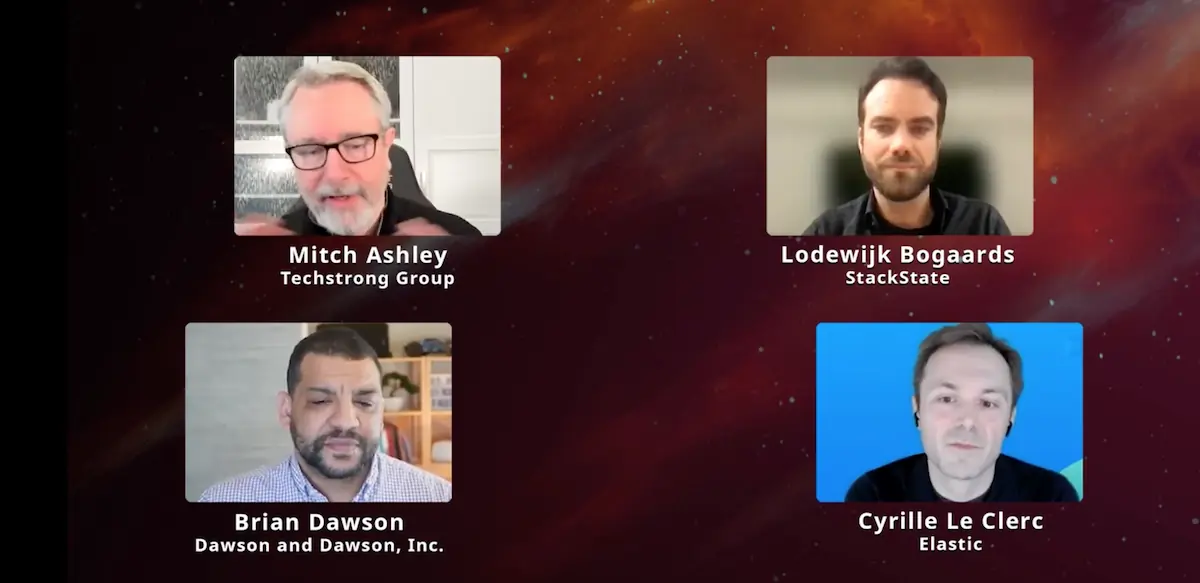TechStrong CTO and cofounder Mitch Ashley sat down with Lodewijk Bogaards, Brian Dawson and Cyrille Le Clerc, three industry experts to discuss the present and future of observability.
Brian Dawson has been a developer for 30 years and has worked for Sony Computer Entertainment, CloudBees and the Linux Foundation, among other organizations.
Cyrille Le Clerc is a product management lead at Elastic who’s in charge of AIOps alerting, as well as continuous integration/continuous development (CI/CD) observability.
Lodewijk Bogaards is the CTO of StackState and a lifelong developer and DevOps architect.
Want to hear everything these experts have to say about the future of about the future of observability? Sign up to watch the on-demand session.
The Crucial Role of Observability in the Development Landscape
Observability is more than just the latest shiny, new object. It has become an integral part of the development lifecycle and will likely permeate more and more development teams and decision-makers begin to understand its benefits.
One of the primary drivers of the growing need for observability is the move to the cloud, which, as Brian points out, “has accelerated the move to microservices.” This results in increasingly complex applications and observability enables teams to exercise more control—centralizing how issues are mitigated and how performance is monitored and improved.
Elements of an Effective Observability Strategy
To be effective, observability needs to combat the complexity involved in troubleshooting dynamic environments, adjust to suit the needs of your specific environment and be focused on your specific objectives.
Simplifying Complex, Dynamic Development Environments
An effective observability strategy, according to Brian, needs to manage the complexity of dynamic development environments. “You have a given application or system being built from multiple services that the team that owns the ongoing responsibility for the application doesn’t necessarily own." He notes that this results in increased complexity.
And when that’s combined with an “iterative delivery movement [and] taking on a DevOps perspective where we need to move faster and faster,” the complexity gets multiplied. Observability can support “shared insights and collaborations between the development side and the operation side.”
Adjusting According to the Needs of Your Specific Environment
Lodewijk states that observability, in and of itself, isn’t sufficient—the way it’s used needs to change as well. He explains that, for instance, with Kubernetes, you have “super dynamic environments, which need a different type of monitoring strategy because if everything is just static, you basically plug in your instrumentation and you have a dashboard. The moment something goes wrong, you look at your dashboard.”
With current development tools and tactics, Lodewijk adds, “You also have to change those plugs, and that instrumentation also has to change.”
Focusing on Your Objective
Cyrille points out that each team needs to decide what works best for them instead of trying to emulate the strategies of others. He breaks it down like this: “Some teams are more logs-oriented. Some teams are more metrics on dashboards. And I think it’s very important to understand who you are. What is your culture? Not everybody is Google, and you have to understand who you are to choose the best practices that matter to you.”
Expert Predictions on Observability
Lodewijk says that the future of observability lies in centralizing information in a development environment that’s becoming increasingly decentralized. Also, it will be important to develop preventative measures to protect service level objectives instead of merely reacting to traces, logs and metrics.
Brian describes a future where observability can provide a “predictive view into the degradation of a system.” He also explains that as 2022 moves on, there needs to be a focus on the higher-level objective of what produces the best outcomes for developers and customers.
Cyrille mentions the important role of artificial intelligence and machine learning in the future of observability. He explains that AIOps can play a critical role by designing machine learning systems that collect observability data and provide insights to teams.
Want to hear everything these experts have to say about the future of about the future of observability? Sign up to watch the on-demand session.
The Future of Observability with StackState
IT observability plays a pivotal role in the development lifecycle—not just after a product has been released but also during its earlier phases. StackState provides a topology-powered observability solution that makes it easy to automate root cause analysis, relate changes to incidents, and improve the performance of your system. To learn more, connect with StackState today.



